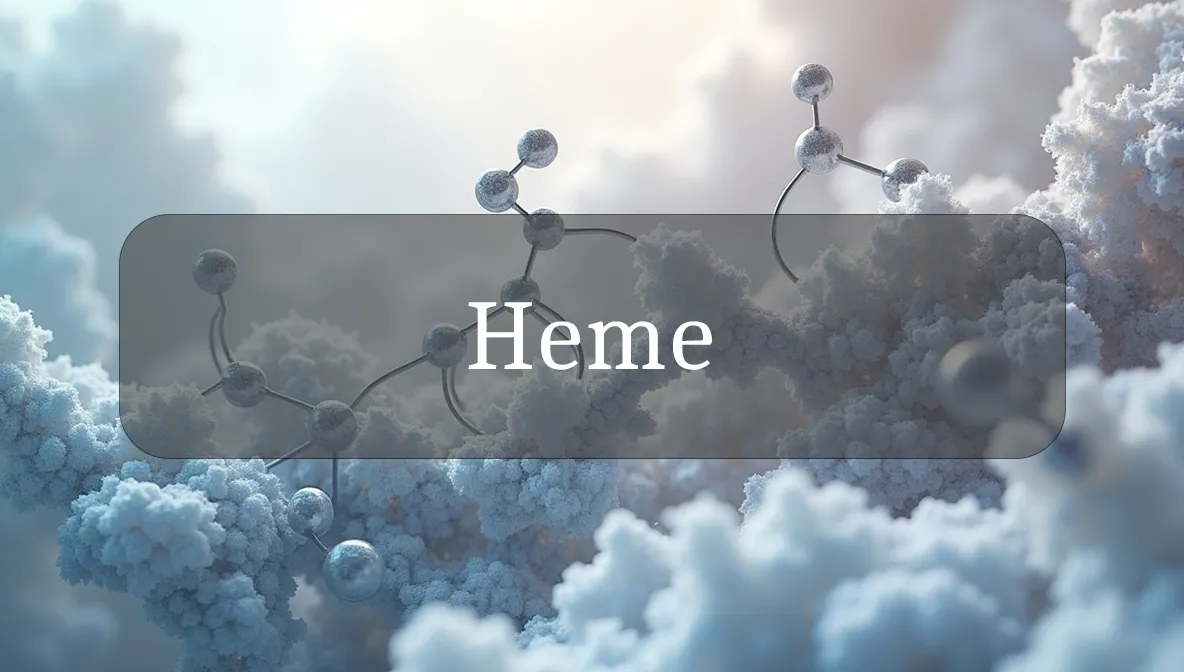Oxygen-Carrying Powerhouse in Your Blood and Cells
Heme is like the unsung hero of your body, a tiny molecule that plays a massive role in carrying oxygen and powering your cells. Found in hemoglobin (in red blood cells) and cytochromes (in cellular energy factories), heme is essential for energy, vitality, and overall wellness. Let’s dive into what heme is, how it supports your health, and how to keep it thriving through diet and lifestyle.
Chemical Identity and Type
Heme is a small, iron-containing molecule called a porphyrin complex. At its core is an iron atom surrounded by a ring-like structure, which gives it the ability to bind oxygen and other molecules. In hemoglobin, heme is embedded in proteins that make up red blood cells, while in cytochromes, it’s part of enzymes in mitochondria (your cells’ energy powerhouses). Heme’s unique structure makes it critical for oxygen transport and energy production.
Biological Role and Benefits
Heme is a vital multitasker, supporting your body in several key ways:
- Oxygen Transport: In hemoglobin, heme binds oxygen in your lungs and delivers it to tissues, fueling muscles, organs, and your brain for energy and function.
- Energy Production: In cytochromes, heme helps transfer electrons in mitochondria, generating ATP (your body’s energy currency) to power everything from exercise to thinking.
- Detoxification: Heme-containing enzymes (like cytochrome P450 in the liver) break down toxins, drugs, and waste, keeping your system clean.
- Red Blood Cell Health: Heme ensures red blood cells are functional, preventing anemia and maintaining stamina.
- Antioxidant Support: Heme-related enzymes protect cells from damage by neutralizing harmful free radicals.
By enabling oxygen delivery and energy production, heme keeps you energized, alert, and resilient.
Dietary or Natural Sources
Your body makes heme using iron and other nutrients, so dietary sources focus on supporting its synthesis:
- Heme Iron Foods (directly provide heme):
- Red Meat: Beef, lamb, and liver (3 oz beef liver: ~5 mg iron).
- Poultry: Chicken and turkey (3 oz chicken: ~1 mg iron).
- Fish and Shellfish: Oysters, clams, and tuna (3 oz oysters: ~8 mg iron).
- Non-Heme Iron Foods (support heme production):
- Legumes: Lentils, chickpeas, and beans (1 cup lentils: ~6 mg iron).
- Leafy Greens: Spinach and kale (1 cup cooked spinach: ~6 mg iron).
- Fortified Foods: Cereals and breads (check labels for iron content).
- Vitamin C Foods: Citrus fruits, bell peppers, and strawberries enhance iron absorption (1 orange: ~70 mg vitamin C).
- B Vitamins: Folate (spinach, beans) and B6 (bananas, poultry) support heme synthesis (1 cup spinach: ~200 mcg folate).
- Supplements: Iron supplements (8–18 mg) or B-complex vitamins may be needed for deficiency, but only under medical guidance.
A balanced diet with iron-rich foods supports heme production naturally.
Signs of Imbalance or Dysfunction
Heme imbalances are often tied to iron or nutrient deficiencies, affecting hemoglobin or cytochrome function:
- Low Heme (Iron Deficiency/Anemia):
- Fatigue, weakness, or shortness of breath.
- Pale skin, brittle nails, or hair loss.
- Cold hands/feet or dizziness.
- Cravings for non-food items (pica, e.g., ice or dirt).
- Excess Heme/Iron (Hemochromatosis, Rare):
- Joint pain, fatigue, or abdominal discomfort.
- Bronze or gray skin tone.
- Liver issues or heart palpitations.
- Cytochrome Dysfunction: Rare genetic disorders (e.g., porphyrias) may disrupt heme in cytochromes, causing light sensitivity, skin issues, or neurological symptoms.
If you notice persistent fatigue, paleness, or unusual symptoms, see a doctor for blood tests (e.g., hemoglobin or ferritin levels).
Supporting Optimal Levels or Function
To keep heme functioning at its best:
- Eat Iron-Rich Foods: Include 1–2 servings of heme or non-heme iron foods daily (e.g., beef or lentils). Adults need 8–18 mg iron daily (men: 8 mg; women 19–50: 18 mg; pregnant: 27 mg).
- Boost Iron Absorption: Pair iron foods with vitamin C (e.g., spinach salad with orange slices) and avoid tea/coffee during meals, as they reduce absorption.
- Support Nutrient Balance: Include folate (beans) and B6 (poultry) to aid heme synthesis.
- Exercise Moderately: Regular activity boosts oxygen use and red blood cell production, supporting heme’s role.
- Supplements (If Needed): Iron or B-vitamin supplements should only be taken if prescribed, as excess iron can harm organs.
Check with a doctor if you’re at risk for deficiency (e.g., vegetarians, heavy periods, pregnancy).
Safety, Interactions, and Precautions
Heme and iron are safe when balanced, but caution is needed:
- Iron Overload: Too much iron (from supplements or hemochromatosis) can damage the liver, heart, or pancreas. Avoid high-dose iron unless prescribed.
- Medication Interactions: Iron supplements may reduce absorption of antibiotics (e.g., tetracycline) or thyroid meds. Take 2 hours apart.
- Medical Conditions: If you have anemia, malabsorption (e.g., celiac), or porphyrias, work with a doctor to manage heme-related issues.
- Allergies: Rare reactions to iron supplements (e.g., rash, nausea) can occur. Use reputable brands.
Fun Fact
Did you know heme gives blood its red color? When heme in hemoglobin binds oxygen, it turns bright red, but without oxygen, it’s darker—explaining why arterial blood is vivid and venous blood is deeper red!
Citations
- National Institutes of Health (NIH): Iron Fact Sheet for Health Professionals.
- Mayo Clinic: Iron Deficiency Anemia.
- Cleveland Clinic: Hemoglobin and Heme Function.
- Harvard T.H. Chan School of Public Health: The Nutrition Source – Iron.
- Journal of Biological Chemistry: Heme in Cytochromes and Metabolism (2020).

